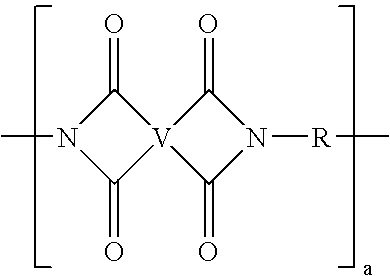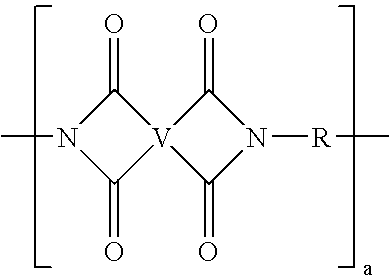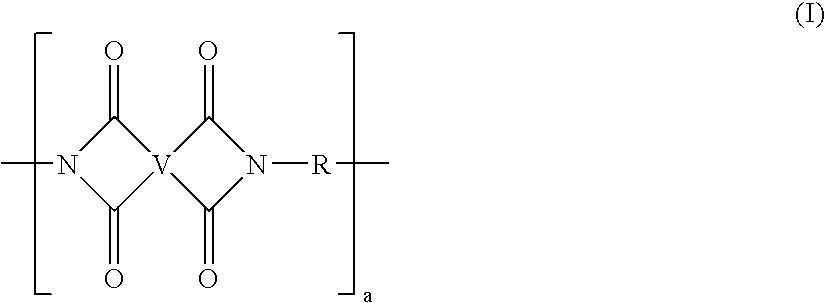Polyimide resin with reduced mold deposit
a technology of polyimide resin and mold deposit, which is applied in the direction of synthetic resin layered products, chemistry apparatus and processes, transportation and packaging, etc., can solve the problems of affecting the proper operation, affecting the performance and aesthetics of the parts made by the process, and operators to potentially dangerous situations, so as to achieve the effect of removing mold deposits
- Summary
- Abstract
- Description
- Claims
- Application Information
AI Technical Summary
Benefits of technology
Problems solved by technology
Method used
Image
Examples
example 1
[0065]Synthesis of low plate out PEI. Into a reaction vessel was charged 567 kg BPADA (approximate composition, 97.6 mole % BPADA, 2.4 mole % mono N-methyl imide of BPADA) and 1155 liters of o-dichlorobenzene (ODCB). The reaction mixture was heated to 150-160° C. Molten MPD (113.4 kg) at 140-150° C. was added over the course of 30 minutes. Simultaneously, 5.1 kg aniline was added. Both the aniline and MPD were pumped through a static mixer while being added to the BPADA. After the MPD addition was complete, the reaction mixture was heated to 180° C. with removal of water. The reaction mixture was moved to a hold tank kept at 170° C. and then fed into a solvent removal system. Solvent was removed using a wiped film evaporator reducing ODCB down to less than 500 ppm. The molten polymer was extruded into strands, cooled in a water bath and chopped to give finished pellets. The resultant polymer had a Mw of about 31,200 g / mole. Tg (glass transition temperature) as measured by differenti...
example 2
[0066]Synthesis of low plate out PEI with stabilizers. Into a reaction vessel was charged 567 kg BPADA (approximate composition, 97.6 mole % BPADA, 2.4 mole % mono N-methyl imide of BPADA) and 1155 liters of o-dichlorobenzene (ODCB). The reaction mixture was heated 150-160° C. Molten MPD (113.4 kg) at 140-150° C. was added over the course of 30 minutes. Simultaneously, 5.1 kg aniline was added. Both the aniline and MPD were pumped through a static mixer while being added to the BPADA. After the MPD addition was complete, the reaction mixture was heated to 180° C. with removal of water. Once the imidization was essentially complete and no further water was evolved, 0.65 kg of a triaryl phosphite and 0.65 kg of a hindered phenol stabilizer were added. The reaction mixture was moved to a hold tank kept at 170° C., and then fed into a solvent removal system. Solvent was removed using a wiped film evaporator reducing ODCB down to less than 500 ppm. The molten polymer was extruded into st...
example 4
[0077]An aniline capped polyetherimide was made using the following process. A round bottom flask equipped with a mechanical stirrer, a condenser and a Dean Stark trap, was charged with 137.6 g BPADA (approximate composition, 97.6 mole % BPADA, 2.4 mole % mono N-methyl imide of BPADA), 1.59 g of aniline, 27.5 g m-phenylene diamine and 285 ml of o-dichlorobenzene (ODCB). The reaction mixture was heated to 180° C. with removal of water. ODCB was distilled away with a nitrogen sweep and the molten polymer was transferred into a pan to cool. Tg as measured by differential scanning calorimetry (DSC) was 219° C. Mw was about 33,600.
PUM
| Property | Measurement | Unit |
|---|---|---|
| molecular weight | aaaaa | aaaaa |
| glass transition temperature | aaaaa | aaaaa |
| weight ratio | aaaaa | aaaaa |
Abstract
Description
Claims
Application Information
 Login to View More
Login to View More - R&D
- Intellectual Property
- Life Sciences
- Materials
- Tech Scout
- Unparalleled Data Quality
- Higher Quality Content
- 60% Fewer Hallucinations
Browse by: Latest US Patents, China's latest patents, Technical Efficacy Thesaurus, Application Domain, Technology Topic, Popular Technical Reports.
© 2025 PatSnap. All rights reserved.Legal|Privacy policy|Modern Slavery Act Transparency Statement|Sitemap|About US| Contact US: help@patsnap.com



